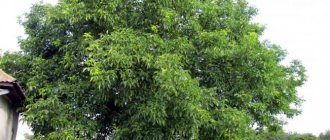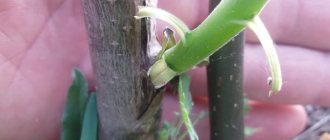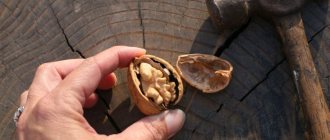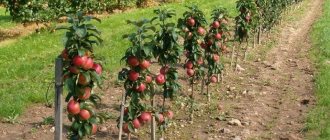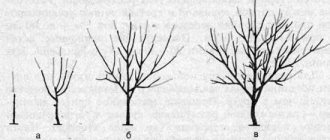In the southern regions of Russia it is difficult to find an area where walnuts do not grow. In recent years, gardeners in northern latitudes have been acclimatizing this type of tree, so many people are interested in planting seedlings in the fall.
Let's talk about how to choose the right planting material and what points you need to pay special attention to. We will also tell you which place is best to choose and in which months to plant walnuts so that they take root.
Walnut planting dates
When choosing the time to plant walnuts, you need to remember that this crop is heat-loving, and therefore sap flow slows down as the temperature drops. If you miss the favorable moment, the walnut may not have time to adapt to the new place and will die in the winter.
To avoid this, it is recommended to plant a tree in the spring; autumn planting is suitable for more experienced gardeners who know the vagaries of the weather in their area and can predict the onset of cold weather in the near future.
The approximate dates for planting walnuts in the fall can be seen in the table.
| Walnut growing region | Best time to plant |
| Moscow, Moscow region, Volga region, Middle zone | Early to mid September, best spring |
| Ural, Siberia, North-West | Only spring |
| Krasnodar and Stavropol territories, republics of the North Caucasus, Crimea | October November |
You can navigate by leaf fall - as soon as the nearest walnut trees begin to shed their leaves, you can plant young seedlings and seedlings without fear. In this case, the air temperature during the day should not be below zero, and the soil should not have time to freeze.
It’s good if 15-20 days pass between planting the tree and the first frost, then the nut will have time to adapt to the new conditions and go into the winter prepared.
How to vaccinate in winter
Cuttings are prepared until late autumn. For these purposes, cuttings from one-year-old shoots 10-14 centimeters long are cut. Then they are placed in a container with wet sawdust (can be replaced with wet sand) and kept in a room where the temperature is kept from 0 to 5 degrees. Of course, you need to periodically check their condition. If necessary, the cuttings should be wetted and stored until spring.
Rootstocks - on which walnuts can be grafted - are also harvested in the fall, before the onset of severe frosts. Wrapped in a plastic bag, stored in the same conditions as the cuttings.
Winter vaccination is carried out at the end of February or at the beginning of March. The day before the procedure, to warm up the rootstocks and cuttings, leave them at a temperature of 15 degrees, but no more. If desired, before vaccination, you can place it in special solutions - growth stimulants. The most effective grafting method in this case will be the method of simple and improved copulation.
Wrap the grafted tree in a plastic bag and leave containers with wet sand and leave at a temperature of at least twenty degrees for two weeks. Then the permanent storage location until the beginning of real spring will be conditions with an air temperature of three to five degrees.
When the soil temperature warms up - this is mid-April - the grafted trees are transplanted to a permanent location. In terms of grafting methods, walnuts are no different from other types of trees, but you need to pay attention to all the subtleties.
Grafting an adult walnut tree with cuttings
How to choose a good seedling
Even compliance with all the principles of agricultural technology cannot guarantee a positive result when planting a walnut orchard if the planting material was initially of poor quality. Special attention must be paid to the condition of the seedlings, which is why it is recommended to make purchases in specialized nurseries - there is more choice and the quality is higher than that offered by market sellers.
If finances allow, it is better to buy a two-year-old walnut seedling - it takes root better and requires less care. However, you can also grow an excellent tree from annual seedlings, but you will have to put in more effort.
A good seedling can be identified by the following characteristics:
- There is one main trunk and no cracks, cuts or other damage.
- The roots are straight, there are no signs of rot or disease.
- The grafting zone is clearly visible, the tissues have healed and grown together well.
The height of a one-year-old walnut seedling is no more than 40 cm, while a two-year-old one can reach a length of one and a half meters, then before planting its branches will need to be shortened so that their length is no more than 80 cm.
Some gardeners do not prune at all before planting. This measure is justified if the tree is annual, or is sold with a closed root system, in which the smallest roots are not damaged.
Comments (9)
Marina
10/24/2017 at 00:28 |
I can’t say that walnuts are picky and difficult to grow in your dacha; we have several of them growing there. Children adore it, although in the fall these fruit shells are green and get your hands very dirty.Answer
Svetlana
12/21/2017 at 02:48 |
Where does it grow for you? What region? I live in the Samara region and the winter is good. To whom I tell that there are three walnut trees, they don’t believe me! There are good varieties that can withstand significant minus.
Answer
Yulia Expert Plodogorod
01/14/2020 at 21:15 |
Hello Svetlana! Many modern varieties of walnuts are resistant to cold and disease and at the same time produce stable, high yields. Among these varieties we can highlight the Ideal walnut variety.
This plant is relatively small, as it develops it reaches 5, less often 7-8 meters. The tree can withstand temperatures dropping to -30-35 degrees and quickly enters the fruiting phase. Sometimes, even on annual plants, fruits appear. More than 100 kg of harvest can be harvested from a developed plant. The average fruit weight is 9-11 grams.
Another popular variety that is resistant to various disasters is the Giant. Fruiting can be expected in the fifth year after planting. The height of the tree is about 5 meters, the crown is spreading. Fruit weight is 12-13 grams. The described variety grows well throughout almost the entire territory of the Russian Federation.
Among the vigorous-growing walnuts that are resistant to cold winters can be called Krasnodar early-fruiting. Rarely becomes infected with harmful insects and diseases. The fruits are medium, about 8-9 grams. The Pinsky walnut variety has similar characteristics. The difference is earlier ripening.
Answer
First
03/15/2018 at 12:25 |
It’s also surprising to me that walnuts grow in Samara. My Saratov relatives were unable to raise him. I myself am in the south, they are here at every turn. And I'm happy for you. Maybe you managed to develop a frost-resistant variety?
Answer
Andrey Expert Fruit Garden
10/13/2018 at 01:36 |
Good afternoon One walnut plant cannot yet be called a VARIETY! In order to apply for an Original Patent, it is necessary to carry out a number of studies. These include: 1) Will the qualities of this plant be preserved after 10 years; 2) Will the properties of the plant be preserved when propagated by seeds; 3) Will the properties of the plant be preserved during its vegetative propagation?
In addition, it is necessary to take into account the conditions in which the plant grows. The fact is that walnuts do not tolerate drafts. If the plant is freed from them, it can successfully withstand a drop in temperature, even down to -32°C.
Answer
Masha
06/27/2018 at 00:20 |
I am from Belarus, and I have had walnuts growing on my plot for more than 10 years. But what’s sad is that in the last couple of years nuts have practically stopped growing on it. The tree looks healthy, I don’t even know what’s wrong(
Answer
Yulia Expert Plodogorod
01/14/2020 at 21:29 |
Hello, Masha! Sometimes healthy-looking walnut trees do not produce fruit due to excessive thickening of the crown. Inspect your tree. If the branches inside the crown are bare, and the foliage is present only closer to the edge, the shoots interfere with one another, grow inward, there is a noticeable large number of short branches, you need to remove the extra ones. It is necessary to carry out sanitation.
Additionally, we recommend fertilizing the tree, if these measures have not been taken before, in order to improve the situation. In addition to organic matter, it is worth adding superphosphates and potassium fertilizers. If the weather is dry and hot, you should water the nut generously. In this case, it is advisable to use a small pressure so that the moisture penetrates into the soil gradually.
Sometimes, due to an excess of fertilizers, the described plants begin to abundantly increase the vegetative mass to the detriment of fruiting. This most often happens if only nitrogen is added in the form of organic matter. In the described case, it is important to refrain from fertilizing in the near future, and in the future to choose the right products, providing the tree with elements that affect fruiting.
Answer
Alina
03/15/2020 at 00:15 |
It's quite nice to have your own walnuts, because they are still expensive in stores. But then the tree grows too big. In a small area you can’t make much of a splash.
Answer
Yulia Expert Plodogorod
03/16/2020 at 01:31 |
Hello, Alina! To ensure that such a plant does not take up much space on the site, we recommend paying attention to low-growing varieties. Many of them are distinguished by their rapid entry into the fruiting phase.
The Dobrodar variety is an undemanding, low-growing variety. This crop tolerates low temperatures in winter and produces consistently high yields. The fruits are large, uniform in size, with good taste.
The grape-like nut begins to bear fruit already in the third year after planting. It is resistant to weather disasters and has high yield. The trees are not tall, but have a wide spreading crown. The fruits have a thin shell that cracks easily. Nuts of this variety are often used as dessert and in cooking.
The Nut Rain variety is also low-growing. The culture received its name due to high yields, as well as the rapid fall of fruits that have reached ripeness.
The Industrial walnut variety is distinguished by its compact crown and a large number of simultaneously ripening fruits. Because of this, this variety is often used to cultivate nuts for sale. Trees can be placed quite densely, which will not affect their development and fruiting. The harvest can be expected already in the second year after planting.
Answer
Which place is better to choose
The first thing you need to remember when choosing a place to plant a walnut on a plot is that the roots of an adult walnut are massive, long and located relatively close to the surface of the earth. They are capable of lifting soil, thereby destroying the foundations of buildings and outbuildings, garden paths, and other structures. Therefore, the distance between the seedling and buildings must be at least 5 meters.
Other location requirements:
- the plot is sunny - the tree is light-loving and develops well in warmth.
- groundwater is located at a depth of at least 2 m, although there are known cases of successful cultivation of nuts in areas where water occurs at a depth of 0.5-1 m.
- The soil is chernozem, although the walnut feels great on other soils.
It is believed that walnuts can suppress the growth and development of other fruit trees and shrubs located in close proximity. However, according to the assurances of many gardeners, viburnum, raspberry, quince and bird cherry tolerate such a neighborhood perfectly.
The main thing is that the powerful spreading crown of the tree does not deprive these shrubs of sunlight, so it is better if the nut is located on the north or east side of such plantings.
Cross-pollination allows you to obtain more tasty and oily kernels, so it would be good to plant 2-3 trees of different varieties in one area.
Basic stages of transplantation
If you still don’t know how to replant a nut, carefully study the step-by-step instructions.
Consider the following key transplant points:
- It is necessary to plant a tree at the level at which it was previously. If this rule is violated, it will develop slowly, and its fruiting will not begin very soon.
- Plant at such a depth that the root collar is flush with the soil. Build a mound and place the root system. As soon as the first watering is done, the roots will be level with the soil.
- Place the seedling with the side it was facing south.
- On hot days, moisten the soil; the tree does not tolerate severe drought. Moistening the soil will avoid problems with the growth of the seedling.
- For a good harvest, the nut should be planted in such a way as to ensure good pollination. Plant several trees near the nut. The wind can carry pollen over a distance of 300 m.
- The roots of the seedling should not be placed near the surface, as this can lead to the death of the tree. After transplanting, make sure that the roots are not exposed.
Now we know when you can replant a walnut and what recommendations should be followed so that the tree grows healthy and brings a rich harvest.
How to plant walnuts correctly
There are several known schemes for planting walnuts, some simply dig a hole and plant a seedling in it, others strive to observe all the subtleties. In recent years, the method of the Moldovan gardener Nikolai Fedorovich Kiktenko has become widely known. This method will be discussed next.
Preparing a hole for a seedling
Walnut differs from other trees in the principles of absorption of nutrients from the soil. A special type of fungus lives on its roots, which breaks down substances into compounds that can be assimilated by the tree. Therefore, when planting a young seedling, it is important to add humus, which is food for fungi.
A hole for the seedling is dug of any size, but the depth is at least 60 cm. According to the Kiktenko method, several layers of fertilizer are laid, which is why the depth is such. The width is chosen taking into account the size of the roots - they should be located freely in the hole and not bend. The top layer of earth, about a bayonet deep, is folded in one direction, the lower, meager layers in the other. Both piles will be useful, but for different purposes.
The pit is prepared according to the following scheme:
- Ammophoska, the basis of which is phosphorus, is poured onto the bottom. It increases the resistance of roots to low temperatures and strengthens the tree. For one planting hole you need 1 kg of fertilizer, which is scattered over the bottom in an even layer.
- Pour 20 cm of soil that was in the top layer. You can simply fill in everything you dug up first, after removing stones and roots of perennial plants.
- Pour a layer of humus, about half a bucket or 5-6 kg. There is no need to pour soil on top; the roots of the walnut seedling will be placed here.
The remaining soil can later be used to prepare a nutrient mixture and to create a border around the seedling.
It’s good if the planting hole can be prepared a week before planting the seedling.
Instructions for planting nuts in autumn
The hole has been prepared, the seedling has been purchased and now you can start planting it. If the branches are long, then they are shortened to a height of 80 cm from the main trunk or from the root collar if the seedling does not have branches. The roots are carefully examined, damaged and dry ones are removed.
The walnut's root system is weak at first; a strong wind can twist the seedling. Therefore, you need to stock up on support - prepare a stake up to 2 meters long from durable wood - ash or acacia.
Instructions for planting walnuts in the fall:
- Stepping back from the center of the hole about 15-20 cm to the north, drive the prepared peg into the ground.
- Place the seedling in a previously prepared hole so that the grafting is approximately at the level of the top layer of soil. The trunk should be south of the support pillar. Straighten the roots, make sure there are no creases.
- Mix the previously dug soil with humus in equal parts, cover the root system of the seedling with the resulting mixture, periodically tugging it upward. With this approach, voids under the roots are eliminated, the presence of which is undesirable.
- Carefully compact the soil with your foot. At this stage, the main thing is not to overdo it, so as not to break the roots and damage the fragile tree.
- Make a layer 20-25 cm thick from a mixture of cow dung and straw, where the straw content is approximately 80%. If cow manure is not available, horse manure can be used. This layer will protect the roots of the tree from freezing and there will be a greater chance that it will take root.
Having planted a walnut tree, retreat 50 cm from the trunk and build a barrier from the remaining earth around the perimeter of the crown. It will retain moisture, so the height should be at least 15-20 cm. In spring, such a barrier ensures a uniform supply of nutrients to the roots.
The tree is watered abundantly; at least 60 liters of water (6 large buckets) are needed. With such watering, the soil is saturated with moisture to the limit, compacted, and even the slightest voids under the roots are eliminated. At the final stage, the seedling is tied to a support; you can use figure eight mating.
If the soil is loose, then tie it up after 2-3 days, when the soil has completely settled.
Step-by-step instructions for the procedure
in autumn
The practice of gardeners shows that trees planted during leaf fall take root best. In order to properly transplant a nut, the stages of this procedure have been developed.
- Dig a hole of the appropriate size; the larger and older the seedling, the larger it should be.
- A drainage layer (fragments of bricks, pottery, small stones), ammophos, and then some earth are poured onto the bottom of the pit.
- Install the seedling, carefully straightening its root system.
- Add soil so as not to cover the grafting site.
- Carefully twist the plant so that the earth crumbles and there are fewer voids.
- Then the soil is compacted and covered with mulch.
- Water at the rate of 6 buckets of water per plant.
Important!
Trees transplanted in the fall may freeze during frosts. Therefore, it is important to plant them as deep as possible.
The following video shows how to properly replant a plant in the fall:
in spring
Spring transplantation of a walnut tree has the following stages:
- The tree is watered abundantly several hours before transplanting. The soil should be saturated with water to make it easier to free the roots.
- The seedling is removed and the roots are trimmed a little. The sections are treated with ash.
- Cover the plant with fertile soil to half the depth of the hole. The tree is placed in the middle so that it is located at the same height as it grew.
- Fill the hole completely with soil and water it abundantly.
Mulching is used to ensure that the soil does not dry out and maintains maximum moisture.
Further care of the seedling in the fall
Walnut is an unpretentious crop and therefore does not require special care. However, to improve the survival rate of a tree in a new place, you need to work a little. In autumn you need to monitor the condition of the soil.
If it dries out and there is no rain, then let’s water it at a rate of a bucket or two for each tree. Water the nut until frost sets in, then stop. If autumn is rainy, then there is no need for watering.
When using the Kiktenko method, fertilizing will not be needed for the entire next year. The only thing you need to do is to update the protective manure-straw layer from time to time or replace it in the spring with a more accessible mulch. There is no need to be afraid of rodents; they usually do not like the bitter taste of walnut bark, and therefore animals avoid the tree.
It is better not to whitewash or paint a young seedling. However, if you are afraid of frost damage or sunburn, you can wrap the main branches with corrugated cardboard for the winter. You can bleach the nut in the third year after planting.
Advantages of autumn transplantation
Preparing the plant for winter begins long before the onset of cold weather. First, the tree sheds its leaves, then internal processes slow down, and the plant goes into hibernation until spring.
If you plant a nut in a new place in the fall, the tree will adapt and have time to prepare for the onset of cold weather.
Transplanting in the spring is fraught with consequences for plant growth. The point is that you need to have time to move the tree before the buds on the branches begin to swell. Spring often comes quickly, so there is a risk of harm if you start replanting during the active growing season.
Summer is a period of rapid growth and active internal activity. Replanting a walnut at this time is detrimental to the plant.
Basic mistakes
- Purchase of non-regioned varieties. There are many seedlings on the market from various European countries, but trees bred and brought from other climatic conditions are not suitable for growing in Russia. As a result, gardeners are faced with a number of problems that cannot be solved even with very high-quality care.
- Buying the “Ideal” variety, which is very common on the domestic market, and sellers emphasize many of its positive aspects. In fact, this variety is only suitable for growing in warm regions of the country, since at a temperature of -15°C or lower, which is normal for the Moscow region, the shoots freeze, causing the tree to stop bearing fruit.
- It is a misconception that walnuts do not need pruning after they grow. This procedure must be carried out annually; the technology for forming the crown depends on the methods of growing the tree.
Importance and timing of transplantation
The fact is that the walnut has a very powerful and spreading root system. It is dangerous for nearby buildings. In the first years of life, the tree develops mainly a taproot and goes deep, but after 3 years, the lateral roots also begin to actively participate in growth. Thus, in an adult 5-year-old nut, the taproot goes 1.5 m deep, but the lateral ones, strongly “spreading” to the sides, reach a diameter of about 2 m, while they are located at a shallow depth - up to 0.5 m. And here the tree begins to pose a serious threat to the foundation. The problem is that in this case it is almost impossible to replant the tree and in order to save the building you will simply have to destroy the fruit-bearing crop.
The crown of a tree located near the house causes less damage, but, nevertheless, during the season of active leaf fall, cleaning them can also cause inconvenience. Therefore, it is worth replanting the nut in a timely manner and thereby avoiding a number of problems.


